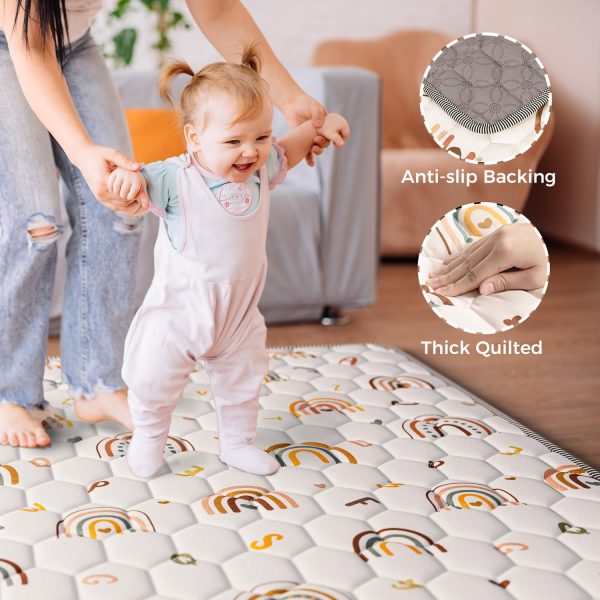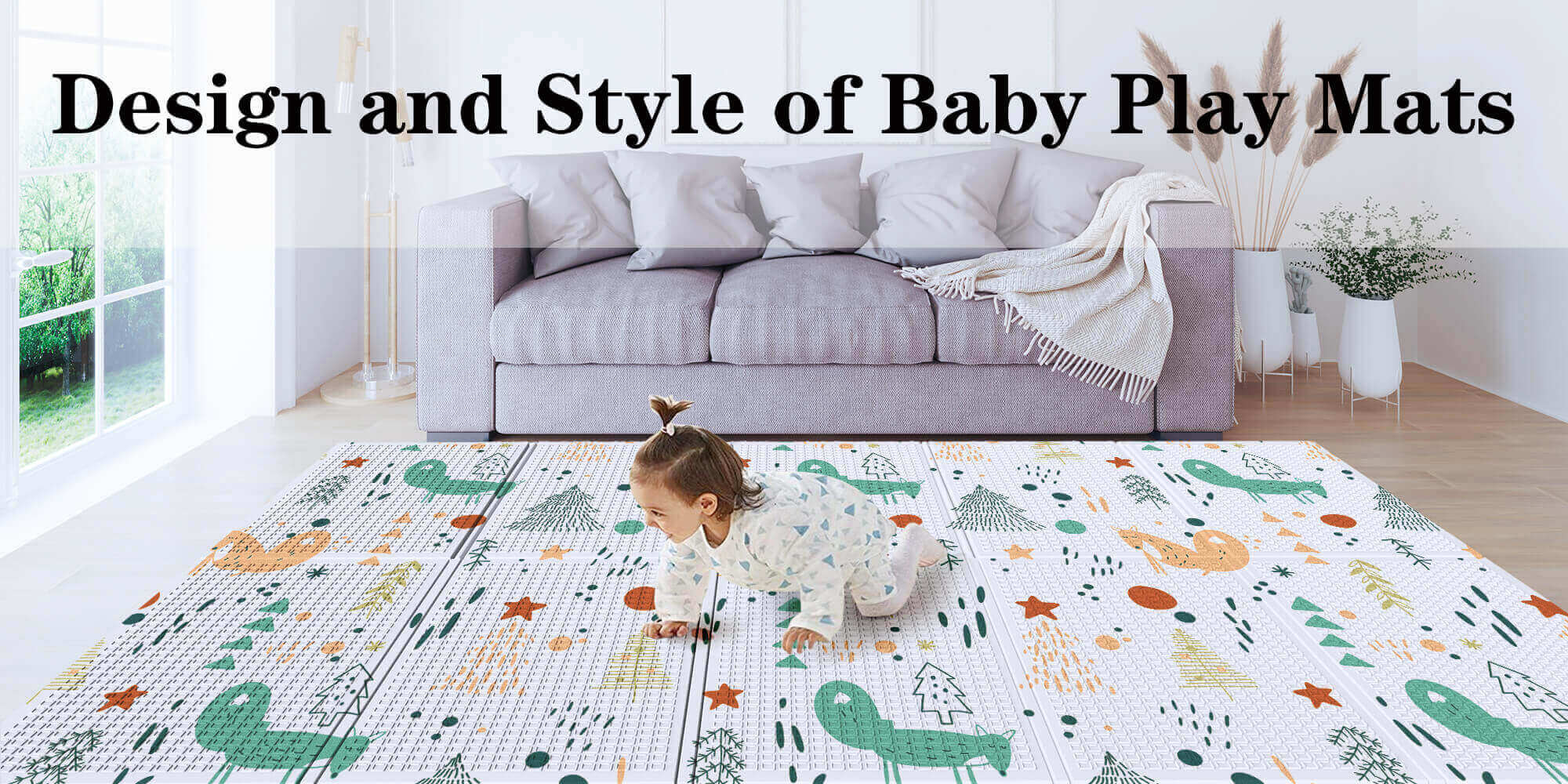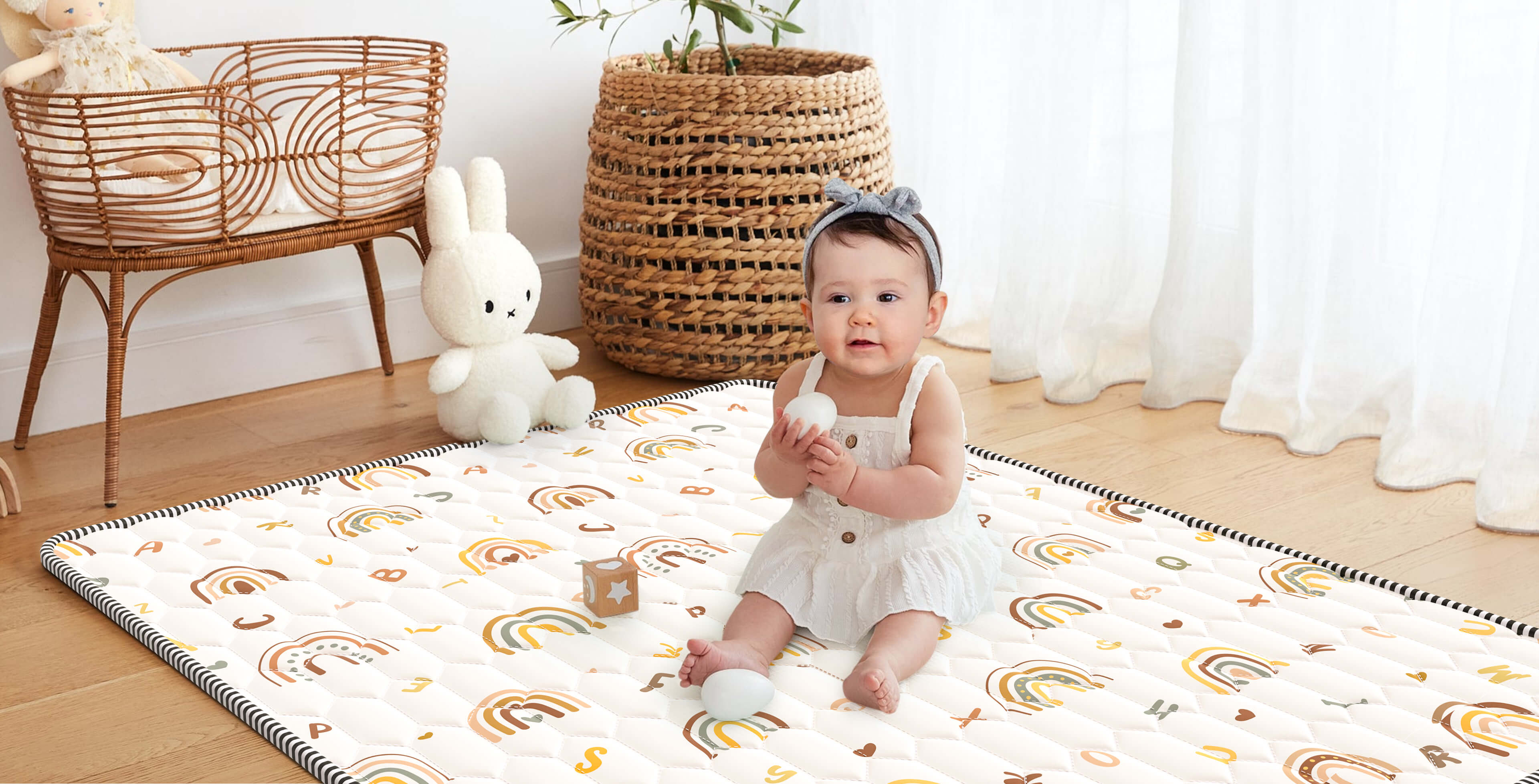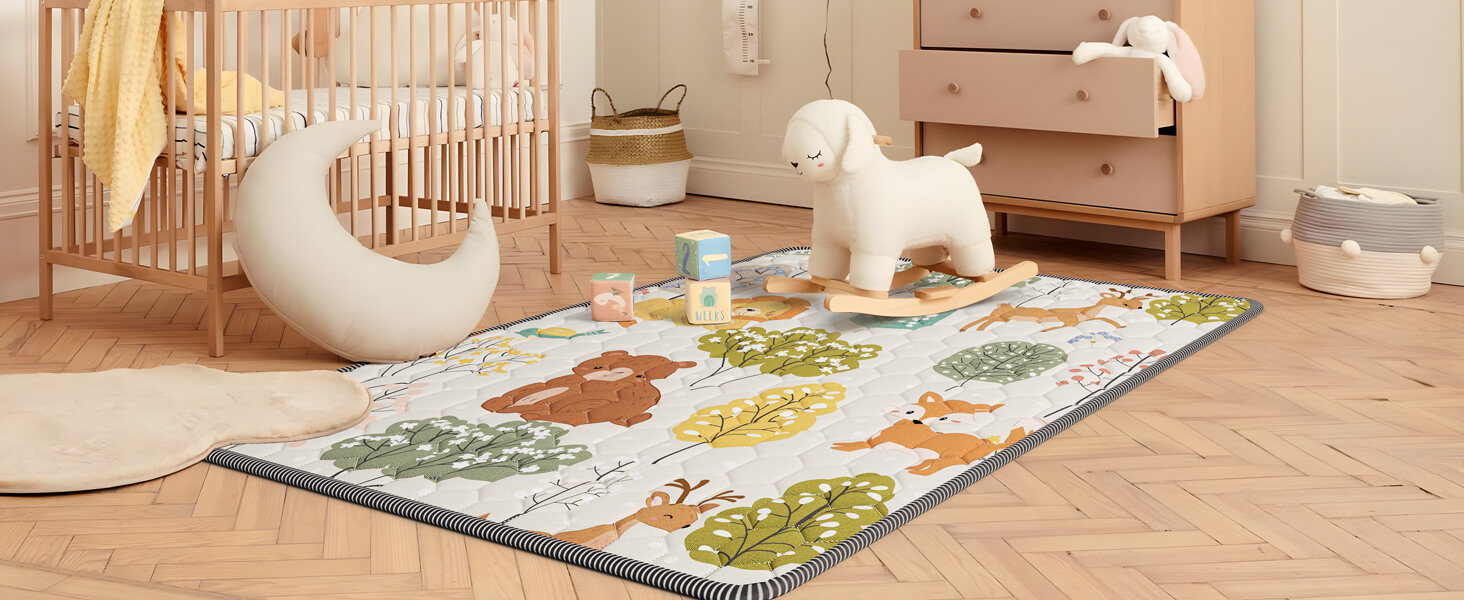
- Home
- Baby Product Guides
- The Benefits of Parents Using Baby Play Mats
The Benefits of Parents Using Baby Play Mats
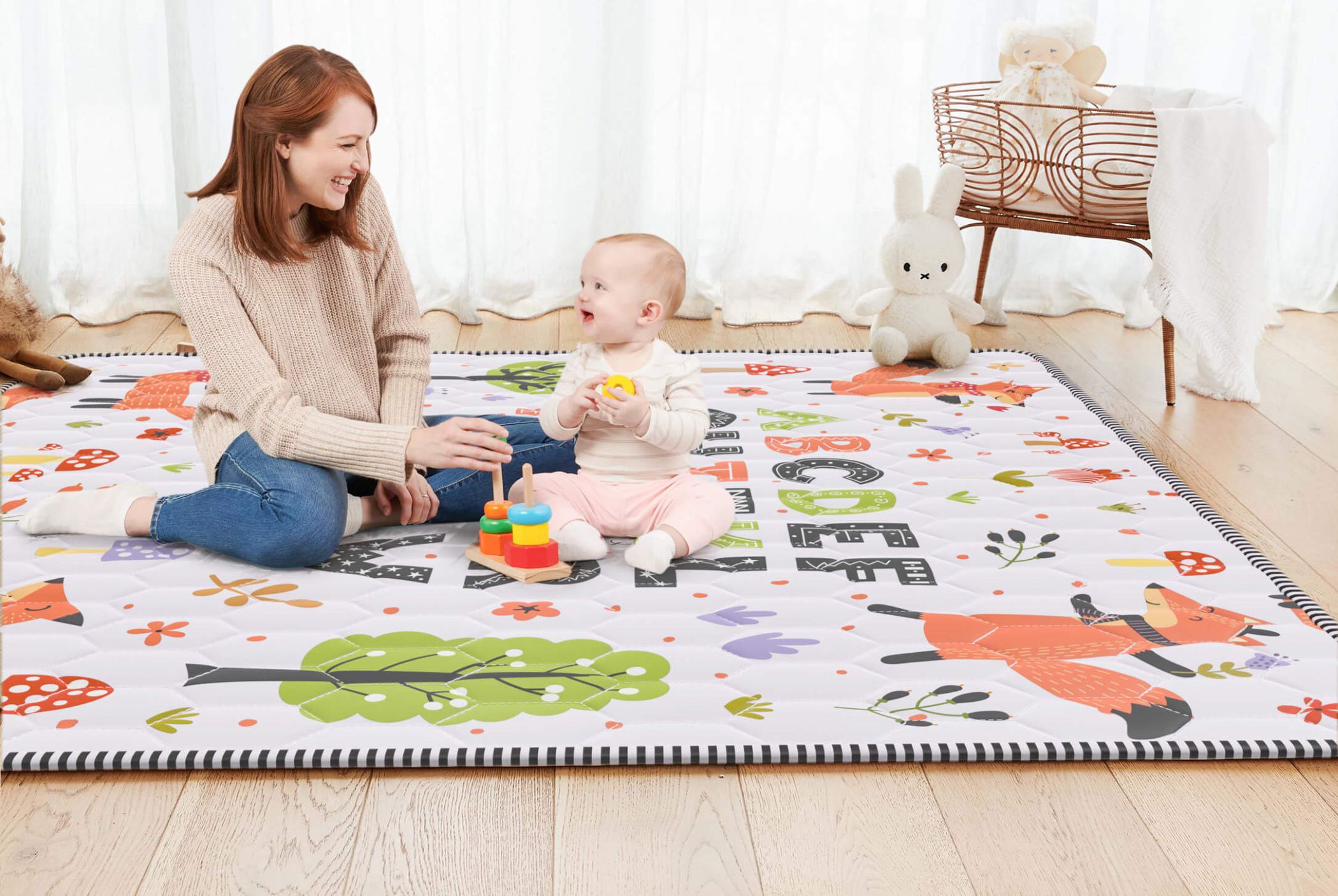
As parents, ensuring a safe and stimulating environment for your baby is essential. A baby play mat is a key tool for achieving this. These mats are designed to aid your child’s development while providing convenience and peace of mind. In this guide, we’ll cover the many benefits of baby play mats. These include safety, sensory stimulation, motor skill development, and more. Whether you’re a new parent or upgrading your baby gear, a play mat is a valuable addition. It supports your child’s growth and enhances their overall development.
1. Safety: A Controlled Play Environment
One of the primary reasons parents opt for baby play mats is safety. These mats provide a cushioned, designated play area where your baby can explore without the risks posed by hard floors or unsafe surfaces. Key safety benefits include:
Cushioned Surface for Protection
One of the primary safety features of baby play mats is their cushioned surface. Most mats are made from high-quality foam, memory foam, or soft fabric materials designed to absorb impact. Babies are naturally prone to falling or rolling over as they explore movement. The cushioned material helps to prevent injuries, such as bruises or bumps, from minor falls or mishaps. Unlike hard floors, which can lead to more severe injuries, the padding on play mats reduces the force of impact when a baby tips over.
This cushioning is especially important for younger babies during tummy time or when they begin learning to sit up, crawl, or walk. A soft, safe surface ensures that babies can build their strength and coordination without causing stress to parents about potential falls.
Non-Slip Base for Stability
Another critical safety feature is the non-slip base commonly found on baby play mats. The backing of the mat is designed to prevent sliding or shifting on smooth surfaces such as hardwood floors or tiles. Babies are naturally curious and tend to move around a lot, making it essential that their play mat stays firmly in place. A non-slip base ensures that the mat won’t shift unexpectedly when the baby crawls, reducing the chances of slipping or tripping.
This stability is also vital for babies who are beginning to pull themselves up to a standing position or take their first steps. A stable mat provides the confidence they need to practice these early milestones safely.
Defined Play Area
Play mats offer a clearly defined play zone, which is crucial in creating a controlled environment for your child. A designated area helps keep your baby’s toys, snacks, and other essentials within a safe, hygienic zone, away from dirt, dust, or any objects that might be dangerous. It also helps you, as a parent, to keep track of where your baby is and what they are interacting with, offering better supervision and peace of mind.
By designating this controlled play space, you minimize the risk of babies crawling or rolling into hazardous areas in your home, such as near electrical outlets, sharp corners, or heavy furniture.
By creating a controlled environment, parents can focus on nurturing their baby’s development without constantly worrying about potential dangers.
2. Supporting Motor Skill Development
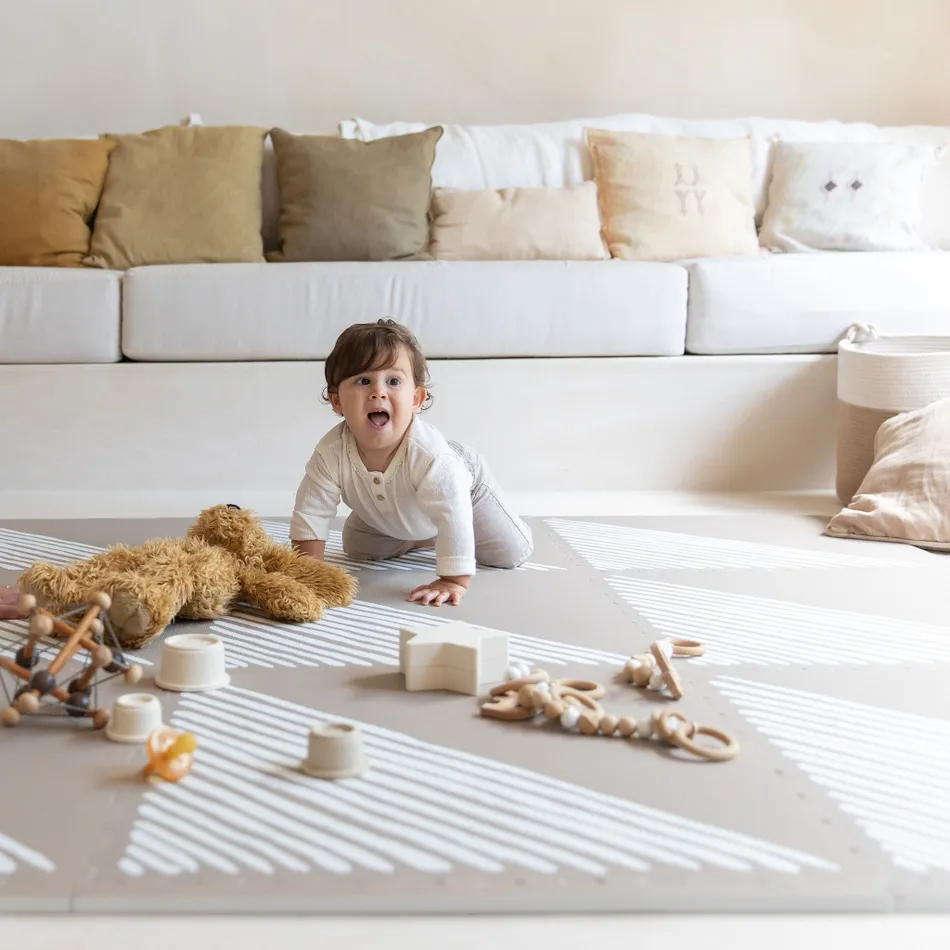
Baby play mats are not just for safety—they are integral to a child’s physical development. These mats provide an ideal space for babies to practice important motor skills, including:
Tummy Time: Tummy time is crucial for building strength in a baby’s neck, shoulders, and arms. The padded surface of the mat encourages babies to stay on their bellies longer, promoting the development of core muscles necessary for crawling and sitting up.
Crawling and Rolling: With enough space on a play mat, babies have the freedom to explore their movement abilities. Crawling helps with coordination and muscle strengthening, while rolling supports flexibility and balance.
First Steps: Some baby play mats have interactive designs that encourage standing and walking. Whether through attached toys or textured surfaces, these mats give babies confidence in taking their first steps in a safe, padded environment.
As babies explore movement, the mat becomes a familiar space where they can practice and grow.
3. Cognitive and Sensory Development
Baby play mats are designed to stimulate a child’s senses and encourage early cognitive development. Many play mats feature various textures, colors, and patterns that engage your baby’s growing brain.
Visual Stimulation: Bright colors, high-contrast patterns, and fun designs help to stimulate a baby’s vision, especially during the first few months when visual perception is still developing.
Tactile Exploration: Different materials and textures on play mats invite babies to explore with their hands, fostering sensory development. Some mats feature soft fabric, raised edges, or textured areas that make touch exploration exciting.
Interactive Toys and Activities: Many modern play mats come with attached toys like mirrors, rattles, or hanging elements. These toys encourage babies to reach, grasp, and learn cause-and-effect relationships, further boosting cognitive skills.
Parents can feel confident that while their child is playing on the mat, they’re developing essential skills in a fun, engaging way.
4. Portable and Convenient for Busy Parents
Parents lead busy lives, and baby play mats offer a convenient solution for creating a designated play space anytime, anywhere. The portability and ease of use are significant benefits for parents looking for flexibility in their child’s playtime routine.
Lightweight and Easy to Move: Most baby play mats are lightweight and foldable, allowing you to set up a play area in different rooms or even take it along when traveling or visiting relatives. This portability ensures that your baby always has a safe, familiar space to play in.
Easy to Clean: Baby play mats are typically made from materials that are easy to wipe down or machine washable. This is crucial for maintaining hygiene, as babies often drool, spit up, or bring food onto the mat. A clean play mat helps prevent the spread of germs and keeps your baby healthy.
Versatility for Different Ages: Many play mats are designed to grow with your baby. They can start as tummy time pads for newborns and transition into play zones for toddlers. Investing in a quality baby play mat ensures longevity and value.
Parents can set up and pack away play areas quickly, making it easier to manage a busy household while ensuring their baby has a fun, safe place to play.
5. Encouraging Independent Play and Exploration
Fostering a sense of independence in babies is essential for their development. A baby play mat offers the perfect space for independent play, allowing your child to explore, interact with toys, and engage in self-directed activities.
Promotes Confidence: A play mat creates a personal space where babies can feel secure to explore on their own. As they interact with toys and different textures, they build confidence in their abilities.
Boosts Problem-Solving Skills: Many mats come with interactive toys that encourage babies to figure things out—whether it’s understanding how to make a rattle sound or discovering how to reach a hanging toy. These challenges help develop problem-solving skills.
Strengthens Focus and Attention: When babies engage with toys and activities on the mat, they practice focusing on tasks and extending their attention span—skills that are vital for future learning.
Independent play also gives parents some time to complete tasks around the house while keeping an eye on their child.
6. A Safe Space for Social Interaction
Play mats are not only great for solo play; they also provide an excellent space for social interaction with parents, siblings, or even other babies.
Parent-Baby Bonding: Spending time on the play mat with your baby is an opportunity for bonding. You can play with toys together, talk, sing, or simply cuddle, strengthening your connection.
Sibling Interaction: If you have older children, a baby play mat can serve as a safe space for supervised play between siblings. Your older child can help show the baby toys, creating a sense of responsibility and nurturing.
Playdates: Baby play mats are ideal for playdates, giving babies a designated area to interact with one another. Social play helps babies develop important social skills like sharing, communication, and empathy.
A baby play mat serves as a foundation for your child’s social and emotional development, encouraging meaningful interactions within a safe environment.
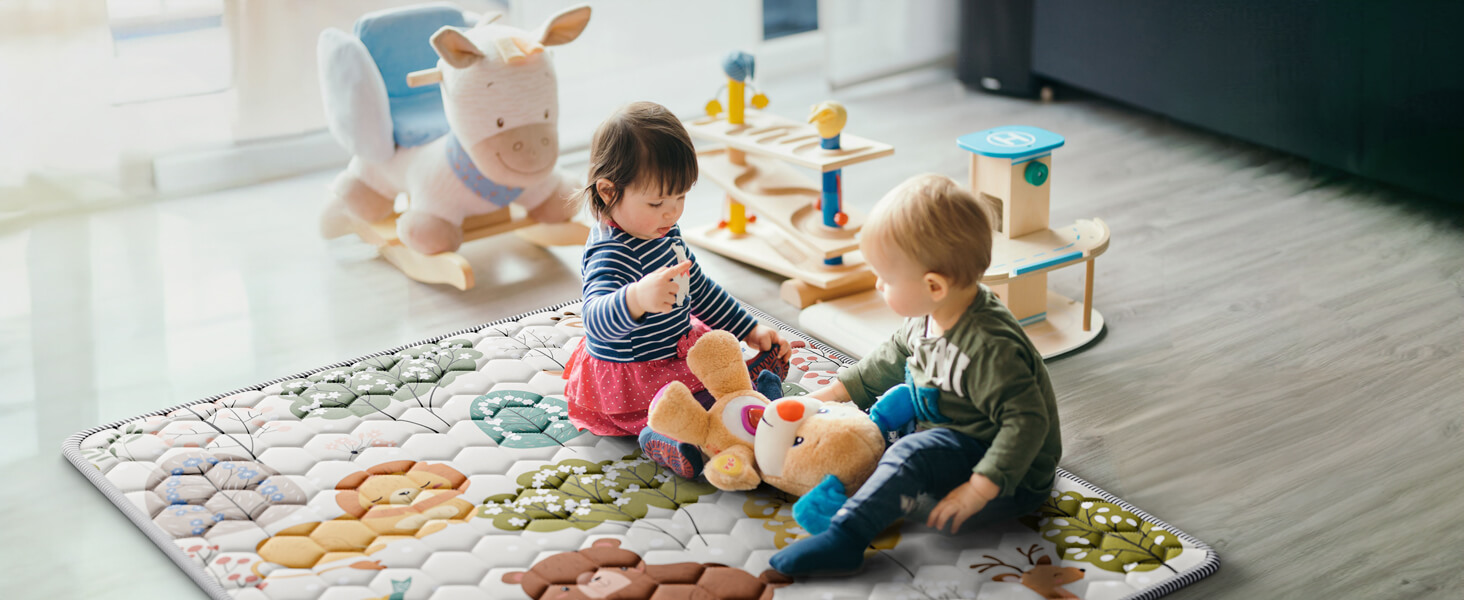
7. Non-Toxic and Environmentally Friendly Options
With growing awareness of the importance of non-toxic materials, many baby play mats are designed with safety and the environment in mind. Parents can now choose from a wide variety of play mats that are free from harmful chemicals and eco-friendly.
Non-Toxic Materials: Many baby play mats are made from non-toxic materials such as BPA-free foam or organic cotton. This ensures that even if your baby puts their mouth on the mat or spends extended time on it, they are not exposed to harmful chemicals.
Hypoallergenic Surfaces: Some mats are designed specifically for babies with allergies or sensitive skin. These hypoallergenic surfaces minimize the risk of irritation, providing a safer play area for all babies.
Eco-Friendly Choices: There are several eco-friendly play mat options on the market, made from sustainable materials that are biodegradable or recyclable. This choice reflects an increasing trend toward more environmentally responsible baby products, aligning with the values of environmentally-conscious parents.
Parents who prioritize safety and sustainability can rest assured knowing there are numerous healthy options available.
8. Enhancing Home Aesthetics
Today’s baby play mats are not just practical—they can also complement your home’s décor. No longer limited to bright primary colors, play mats now come in a variety of stylish designs that blend seamlessly into modern living spaces.
Chic Designs: From neutral tones to elegant patterns, play mats can be both functional and visually appealing. This allows parents to maintain the aesthetics of their home while providing a safe area for their baby to play.
Customizable Spaces: Some play mats come in modular designs, allowing parents to customize the size and shape of the mat to fit any room. This adaptability ensures that the play mat can be tailored to different spaces as needed.
Having a stylish and functional play mat means that your home can remain a beautiful and organized space even with a baby around.
Conclusion
In conclusion, baby play mats are essential and versatile tools for modern parents. They offer benefits ranging from safety to sensory development, motor skills, and cognitive growth. These mats support your child’s development in various ways, providing a safe, interactive, and engaging environment. Your baby can thrive in a space designed for exploration and learning, while you enjoy peace of mind.
When choosing a baby play mat, consider the features that suit your needs. Focus on material safety, design, and portability. Your baby will have a safe, enriching space to grow, explore, and develop. At the same time, you’ll appreciate the convenience and flexibility it adds to your daily routine.

